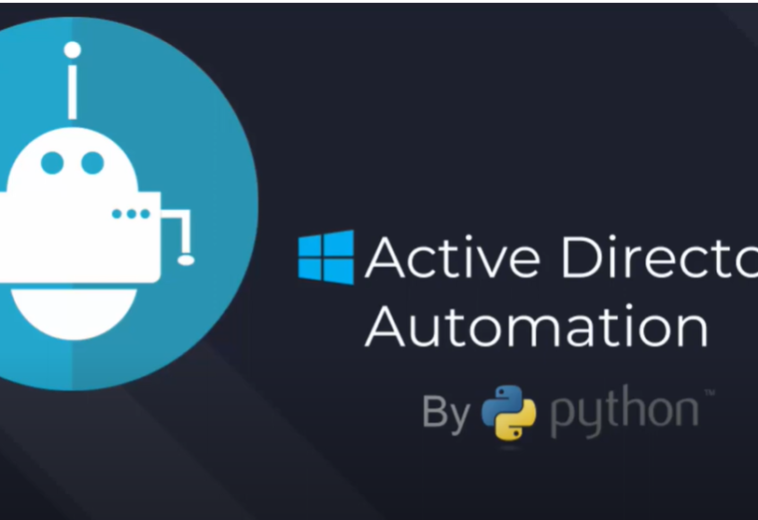Automate Active Directory
Active Directory Automation: Understanding the Power of Active Directory – Part 1
Are you ready to streamline your VFX studio’s user management and authentication processes? In this video tutorial series, we dive into the world of Active Directory automation. In Part 1, we start by demystifying the concept of Active Directory and exploring its key features and functionalities.
Join us as we explain what Active Directory is and how it serves as a centralized repository for user accounts, authentication, and network resources. Discover how Active Directory simplifies user management, enhances security, and enables seamless integration with various applications and services.
Whether you’re a VFX studio owner, a system administrator, or an IT professional, understanding Active Directory is essential for building an efficient VFX pipeline. Stay tuned for future videos in this series, where we’ll delve into the practical aspects of automating Active Directory tasks.
To learn more about automating Active Directory or to build a customized VFX pipeline for your studio, feel free to email us at contact@hqvfx.com. And don’t forget to hit the subscribe button to stay updated with our latest tutorials and valuable content.
Active Directory Automation: Setting Up ThreadedServer with RPyc Python – Part 2
Welcome back to our Active Directory automation series! In Part 2, we dive into the practical implementation of automating Active Directory tasks using RPyc Python and ThreadedServer. Join us as we explore how to set up a ThreadedServer with RPyc Python, enabling seamless communication and interaction with Active Directory.
Learn the step-by-step process of configuring RPyc Python, establishing a connection with Active Directory, and leveraging the power of ThreadedServer to execute tasks efficiently. Discover how this combination allows you to automate common Active Directory operations, such as user provisioning, group management, and permissions assignments.
Whether you’re a VFX studio owner, a system administrator, or an IT professional, this video is a must-watch for harnessing the power of automation in your Active Directory environment. Stay tuned for future videos in this series, where we’ll delve deeper into advanced automation techniques and use cases.
To learn more about automating Active Directory or to build a customized VFX pipeline for your studio, feel free to email us at contact@hqvfx.com. And don’t forget to hit the subscribe button to stay updated with our latest tutorials and valuable content.
Active Directory Automation: Utilizing Subprocess Check Output in RPyC Exposed Methods – Part 3
Welcome to Part 3 of our Active Directory automation series! In this video, we dive deeper into the world of automating Active Directory tasks using RPyC and explore the power of subprocess check output. Join us as we demonstrate how to leverage subprocess check output within RPyC exposed methods to automate complex operations in your Active Directory environment.
Learn how to utilize subprocess check output to execute commands and retrieve the output directly within your RPyC methods. We’ll cover various scenarios, including user creation, group management, and permissions assignments, showcasing the flexibility and efficiency that subprocess check output brings to your Active Directory automation workflows.
Whether you’re a VFX studio owner, a system administrator, or an IT professional, this video is packed with valuable insights on automating Active Directory tasks. Stay tuned for more videos in this series, where we’ll explore additional techniques and best practices for streamlining your Active Directory management.
To learn more about automating Active Directory or to build a customized VFX pipeline for your studio, feel free to email us at contact@hqvfx.com. And don’t forget to hit the subscribe button to stay updated with our latest tutorials and informative content.
Active Directory Automation: Utilizing Argparse for Command Line Options and Subcommands – Part 4
In this video, we explore the power of argparse in automating Active Directory tasks and handling command line options, arguments, and subcommands. Join us as we demonstrate how to leverage argparse to create user-friendly command line interfaces for your Active Directory automation scripts.
Learn how to define and parse command line options and arguments using argparse, allowing you to customize your automation scripts based on user input. We’ll also cover how to create subcommands to handle different operations within your Active Directory automation workflows, making your scripts more modular and flexible.
Whether you’re a VFX studio owner, a system administrator, or an IT professional, this video is packed with practical examples and tips on utilizing argparse for Active Directory automation. Stay tuned for more videos in this series, where we’ll dive deeper into advanced techniques and explore the possibilities of automating complex Active Directory tasks.
To learn more about automating Active Directory or to build a customized VFX pipeline for your studio, feel free to email us at contact@hqvfx.com. And don’t forget to hit the subscribe button to stay updated with our latest tutorials and informative content.
Active Directory Automation: Building Py to Exe Files – Part 5
In this video, we dive into the process of building Python scripts into standalone executable files (py to exe). Join us as we explore various tools and techniques to package your Active Directory automation scripts into executable files for easy distribution and deployment.
Learn how to use popular Python packaging tools such as PyInstaller, cx_Freeze, or py2exe to convert your Python scripts into standalone executables that can be run on any Windows machine without requiring a Python installation. We’ll guide you through the step-by-step process of creating an executable file from your Active Directory automation script and discuss best practices for managing dependencies, including external libraries and resources.
Whether you’re a VFX studio owner, a system administrator, or an IT professional, this video is packed with practical examples and tips on packaging your Active Directory automation scripts for seamless integration into your workflow. Stay tuned for more videos in this series, where we’ll explore advanced techniques and share insights on automating complex Active Directory tasks.
Active Directory Automation: Setting Up the Active Directory Server – Part 6
In this video, we’ll guide you through the process of setting up an Active Directory server. Whether you’re a VFX studio owner, a system administrator, or an IT professional, understanding the steps involved in configuring an Active Directory server is crucial for managing user accounts, security policies, and network resources.
Join us as we explore the key components and concepts of Active Directory, including domain controllers, forests, domains, and organizational units (OUs). We’ll walk you through the installation process, configuration options, and best practices for setting up an Active Directory server in your environment.
Learn how to create user accounts, groups, and organizational units, and how to apply security policies to ensure efficient management of your VFX studio’s network. We’ll also discuss important considerations such as DNS configuration, replication, and trust relationships between domains.
Active Directory Automation: Setting Python Global Variables – Part 7
In this video, we’ll explore the importance of setting Python global variables and how they can enhance your Active Directory automation workflows. Whether you’re a VFX studio owner, a system administrator, or an IT professional, understanding how to leverage global variables in your Python scripts is essential for streamlining your Active Directory management tasks.
Join us as we discuss the concept of global variables and their scope within Python. We’ll demonstrate practical examples of setting global variables to store commonly used values such as server names, credentials, or LDAP query filters. Learn how global variables can improve code readability, simplify script maintenance, and enhance code reusability.
By the end of this video, you’ll have a solid understanding of how to define and utilize global variables in your Active Directory automation projects, empowering you to build a more efficient VFX pipeline for your studio.
Active Directory Automation: Connecting to RPyC Server – Part 8
In this video, we’ll explore how to connect to an RPyC (Remote Python Call) server by using the “send_command” function. If you’re a VFX studio owner, a system administrator, or an IT professional looking to streamline your Active Directory management tasks, this video is for you.
Join us as we dive into the world of RPyC and discover how it enables us to establish a secure and efficient communication channel between the client and server. Learn how to leverage the “send_command” function to send requests and execute remote functions on the RPyC server. We’ll cover the necessary steps to establish a connection, handle exceptions, and retrieve responses from the server.
By the end of this video, you’ll have a solid understanding of how to connect to an RPyC server and utilize the “send_command” function for seamless Active Directory automation. Enhance your VFX pipeline by automating common Active Directory tasks and streamline your studio’s workflow.
Active Directory Automation: Adding New Users with DSADD USER – Part 9
In this video, we’ll dive into the process of adding new users to Active Directory using the DSADD USER command. If you’re a VFX studio owner, a system administrator, or an IT professional seeking to automate user management in Active Directory, this video is for you.
Join us as we explore the powerful DSADD USER command and its capabilities for creating new user accounts. Learn how to leverage command-line tools to streamline the user creation process, including specifying attributes such as usernames, passwords, group memberships, and more. We’ll guide you through the syntax, parameters, and best practices for using DSADD USER effectively.
By the end of this video, you’ll have a solid understanding of how to use the DSADD USER command to automate the creation of new user accounts in Active Directory. Empower your VFX pipeline by automating user management and saving valuable time and effort.
Active Directory Automation: Editing and Removing Users with DSMOD USER – Part 10
In this video, we’ll explore how to edit and remove users in Active Directory using the DSMOD USER command. If you’re a VFX studio owner, a system administrator, or an IT professional seeking to automate user management in Active Directory, this video is for you.
Join us as we dive into the powerful DSMOD USER command and its capabilities for modifying user attributes and removing user accounts. Learn how to leverage command-line tools to streamline the user editing and removal process, including updating attributes such as names, contact information, group memberships, and more. We’ll guide you through the syntax, parameters, and best practices for using DSMOD USER effectively.
By the end of this video, you’ll have a solid understanding of how to use the DSMOD USER command to automate user editing and removal in Active Directory. Empower your VFX pipeline by automating user management and ensuring accurate user data.
Active Directory Automation: Adding and Removing Groups with DSADD GROUP – Part 11
In this video, we’ll focus on adding and removing groups in Active Directory using the DSADD GROUP command. If you’re a VFX studio owner, a system administrator, or an IT professional looking to automate group management in Active Directory, this video is for you.
Join us as we explore the powerful DSADD GROUP command and its capabilities for creating and deleting groups in Active Directory. Learn how to leverage command-line tools to streamline the group management process, including specifying group attributes, memberships, and permissions. We’ll guide you through the syntax, parameters, and best practices for using DSADD GROUP effectively.
By the end of this video, you’ll have a solid understanding of how to use the DSADD GROUP command to automate group creation and removal in Active Directory. Enhance your VFX pipeline by automating group management and ensuring efficient collaboration within your studio.
Active Directory Automation: Adding and Removing Users in Group with DSMOD USER – Part 12
In this video, we’ll dive into adding and removing users in a group in Active Directory using the DSMOD USER command. If you’re a VFX studio owner, a system administrator, or an IT professional seeking to automate user management within groups, this tutorial is for you.
Join us as we explore the powerful DSMOD USER command and its capabilities for modifying user attributes and memberships in Active Directory groups. Learn how to leverage command-line tools to streamline the user management process, including adding and removing users from specific groups. We’ll guide you through the syntax, parameters, and best practices for using DSMOD USER effectively.
By the end of this video, you’ll have a solid understanding of how to use the DSMOD USER command to automate user additions and removals within Active Directory groups. Enhance your VFX pipeline by automating user management and ensuring efficient collaboration within your studio.
Active Directory Automation: Changing User Password with DSMOD USER – Part 13
In this video, we’ll explore how to change the passwords of Active Directory users using the DSMOD USER command. If you’re a VFX studio owner, a system administrator, or an IT professional looking to automate password changes within Active Directory, this tutorial is for you.
Join us as we dive into the DSMOD USER command and its capabilities for modifying user passwords in Active Directory. Learn how to leverage command-line tools to streamline the password change process, ensuring the security and efficiency of user accounts. We’ll guide you through the syntax, parameters, and best practices for using DSMOD USER effectively for password modifications.
By the end of this video, you’ll have a solid understanding of how to use the DSMOD USER command to automate password changes for Active Directory users. Enhance the security of your VFX pipeline by automating password management and strengthening user account protection.
Automate Active Directory: Creating Multiple Users from CSV File – Part 14
In this video, we’ll explore how to create multiple Active Directory users using a CSV file. If you’re a VFX studio owner, a system administrator, or an IT professional looking to streamline the user creation process in Active Directory, this tutorial is for you.
Join us as we demonstrate step-by-step how to import user details from a CSV (Comma-Separated Values) file and automatically create corresponding user accounts in Active Directory. We’ll show you how to utilize scripting and automation techniques to efficiently process and execute bulk user creation tasks.
Learn how to structure your CSV file, map the fields to Active Directory attributes, and leverage PowerShell or other scripting languages to automate the user creation process. We’ll provide you with tips and best practices for error handling, validation, and maintaining data integrity during the import process.
By the end of this video, you’ll have a solid understanding of how to create multiple Active Directory users from a CSV file, saving you valuable time and effort in user management. Empower your VFX studio with efficient user provisioning and enhance your overall pipeline automation.
If you’re interested in learning more about Active Directory automation or building a customized VFX pipeline, feel free to email us at contact@hqvfx.com. Don’t forget to hit the subscribe button to stay updated with our latest tutorials and informative content.
- 240 views





